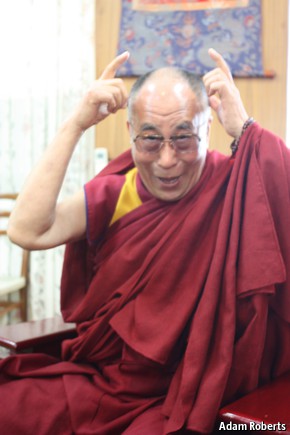

Happy International Women’s Day!
For more than one hundred years, International Women’s Day has honored the advancement of female rights and called attention to the still-present challenges facing women in all walks of life. You can read about the history behind the holiday here. Of course today the Internet is awash with women-oriented articles, some of which are seriously interesting. (Did you know that Rwanda is the country with the most female politicians, Egypt has the smallest gender wage gap, and Georgia has the lowest rates of domestic violence? [The United States, fyi, has the most female Nobel laureates and the most Miss Universe titles.]) And The Guardian published this cool, interactive map of international political rights, where you can move your cursor over each country and find out when women gained the right to vote, stood for election, and were successfully elected. (Another fun fact: Did you know that Myanmar, Thailand, and the Philippenes all granted women’s suffrage before France? And that New Zealand beat the entire world by almost a decade, allowing women to vote as early as 1893? Don’t tell me you never learned anything from Buddha Buzz.)
On the Buddhist Internet front, the Washington Post published an article by Roshi Joan Halifax today, “How women are remaking Buddhism,” that recounts her experience begging for alms in Thailand with Bhikkhuni Patimokkha, who was the first Thai woman to take full bhikkuni ordination at a time when both acts—begging for alms and becoming fully ordained—were illegal. Roshi Joan writes that “in our time, we are seeing a dramatic and positive change for women in all Buddhist orders,” and to some extent, this is true. Here in the United States, at least, women head temples and receive dharma transmission and become ordained as nuns in various traditions. But let’s not get too self-congratulatory just yet.
As the Reverend Danny Fisher points out in his recent post about the Joshu Sasaki Roshi sex scandal, “Let’s Talk About Sex…” “Every time one of these scandals breaks, we talk about the power differential, appropriate relationships between teachers and students, and everything else but misogyny. We don’t want to believe that it has crept into Buddhism and our individual communities, I think.” Or as Barbara O’Brien of About.com wrote about the Joshu Roshi back in November, “And, of course, the Sasaki Situation reeks big time of patriarchy and the notion that the women students were just there for the amusement of the Serious (male) Students and their teacher.”
We American Buddhists like to think of ourselves as free from all of these ugly -ists that afflict the rest of the United States and the world. We don’t like to talk about our sanghas being sexist. We don’t like to talk about our sanghas being racist. We don’t like to talk about our sanghas being agist or homophobic or ableist, because we can’t possibly reconcile the idea that we might be perpetuating harmful societal structures with the image we have of ourselves as being liberal, accepting, all-welcoming Buddhists. Plus, we have the obnoxious habit of breaking out our various Get Out of Jail Free Buddhist Philosophy Cards—Emptiness! Nonduality! Nonattachment!—whenever there’s a thorny moral problem. But if there’s one thing that the Sasaki Situation has reminded us about, it’s that patriarchy and misogyny are alive and well in American Buddhism.
In honor of International Women’s Day, I’d ask that we all look deeply into the ways that we as individuals and as communities might be perpetuating these -ists in our practice. I’m reminded of one friend, who has been practicing the dharma for much longer than I have, who responded to my worries about sexual abuse in Buddhist communities by saying, “Oh, you women practitioners are always worried about that sort of stuff.” Which is to say, let’s also remember: sometimes being flippant about these issues is enough to be actively participating in their continuation.
This week the Economist published two articles about the unrest in Tibet, one a shorter account of the Dalai Lama’s recent politics, playfully titled, “The views of a Marxist demon,” and the other a lengthier and more serious account of the self-immolation crisis called “The limits of despair.” Though neither of the pieces truly tells us anything new—”Marxist demon” reiterates the Dalai Lama’s Marxist sympathies as well as his willingness to abolish the institution of the Dalai Lama at the end of his life; “The limits of despair” takes a rather pessimistic view in its summary of the Tibet crisis—it’s good to see the mainstream media still focusing on Tibet.
Meanwhile, China is relaxing its famously intolerant policy on religion and missionary work by allowing evangelical Christians aiming for mass conversions to flood Tibetan areas. It is, of course, another attempt of China’s to wipe out Tibetan culture and identity. It doesn’t seem, however, like it’s working:
“[Missionaries say,] ‘Well, look at the miracles Jesus is able to perform, to turn water into wine and heal the sick,'” Elizabeth Reynolds, a Fulbright scholar researching Tibetan culture in Xining, explains. “The Tibetan goes: ‘Is that all he can do?’ It’s believed that such special phenomena [already] occur around high lamas.”

Which, I have to admit, gave me a good laugh in the midst of a sad article.
Last but not least in Buddha Buzz today, tech companies continue to take advantage of the meditation/mindfulness craze. A company called HeartMath has just released an app, Inner Balance, that a Mashable review claims could lead you to “Life-Altering Inner Peace.” To use the app, you clip a sensor to your earlobe that measures your pulse and feeds the information into your Apple product. Then the app deduces just how relaxed you are. When it judges that you’re relaxed enough, it indicates that your “heart, mind, and emotions” are “in sync,” and the visuals turn green. If getting to green is too easy, you can up the degree of difficulty by increasing the challenge level, where getting to green becomes harder and harder. To me this sounds unbelievably stressful, not to mention totally counterintuitive to Buddhist practice. But I suppose I should stop expecting these apps to be “Buddhist” and just accept them for what they are: the first sign of the “mindful” zombie apocalypse.
Thank you for subscribing to Tricycle! As a nonprofit, we depend on readers like you to keep Buddhist teachings and practices widely available.